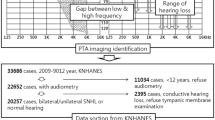Summary
The upper limit of hearing was measured in 6105 otologically normal ears of subjects ranging in age from 5 to 89 years. The results are as follows: in each age group from 5 to 59 years in both sexes, the upper limit of hearing showed an approximately normal distribution if a logarithmic scale was used for the upper limit of hearing axis. The mode of the distribution shifted to a lower frequency with increasing age. Over age 60 years, the distribution became much wider. Standard upper limit age curves were established by calculating 10th, 25th, 50th, 75th and 90th percentiles for each age group. From early childhood where no age variation was recognized in conventional audiometry, deterioration of the upper limit of hearing was already in progress. This deterioration was slight between ages 25 and 39 but at ages over 40 it was accelerated and led to so-called presbycousis. The upper limit of hearing was found to be one of the best parameters for showing the quantitative age-related changes in hearing.
Similar content being viewed by others
References
Borkan GA, Norris AH (1980) Assessment of biological age using a profile of physical parameters. J Gerontol 35:177–184
Conover WJ (1971) Practical nonparametric statistics. John Wiley, New York, pp 110–116
Corliss LM, Doster ME, Simonton J, Downs M (1970) High frequency and regular audiometry among selected groups of high school students. J School Health 40:400–405
Corso JF (1963) Age and sex differences in pure-tone thresholds. Survey of hearing levels from 18 to 65 years. Arch Otolaryngol 77:385–405
Dieroff HG, Schuhmann G (1986) High frequency hearing following otitis media with effusion in childhood. Scand Audiol [Suppl] 26:83–84
Dreschler WA, vd Hulst RJAM, Tange RA, Urbanus NAM (1985) The role of high-frequency audiometry in early detection of ototoxicity. Audiology 24:387–395
Dubina TL, Mints AY, Zhuk EV (1984) Biological age and its estimation, III. Introduction of a correction to the multiple regression model of biological age and assessment of biological age in cross-sectional and longitudinal studies. Exp Gerontol 19:133–143
Erickson DA, Fausti SA, Frey RH, Rappaport BZ (1980) Effects of steady-state noise upon human hearing sensitivity from 8000 to 200000 Hz. Am Ind Hyg Assoc J 41:427–432
Fausti SA, Frey RH, Erickson DA, Rappaport BZ, Cleary EJ, Brummett RE (1979) A system for evaluating auditory function from 8000–200000 Hz. J Acoust Soc Am 66:1713–1718
Fausti SA, Erickson DA, Frey RH, Rappaport BZ, Schechter MA (1981) The effects of noise upon human hearing sensitivity from 8000 to 200000 Hz. J Acoust Soc Am 69:1343–1349
Furukawa T, Inoue M, Kajiya F, Inada H, Takasugi S, Fukui S, Takeda S, Abe H (1975) Assessment of biological age by multiple regression analysis. J Gerontol 30:422–434
Gauz MT, Allen DV (1983) High-frequency Bekesy audiometry: IV. Normative aspects for normal-hearing young adults. J Aud Res 23:43–55
Gauz MT, Smith MM, Hinkle RR (1986) The simplified HF E-800 high-frequency audiometer: Clinical applications. J Aud Res 26:121–134
Harris JD, Myers CK (1971) Tentative audiometric threshold-level standards from 8 through 18 kHz. J Acoust Soc Am 49:600–601
(1982) Acoustics — threshold of hearing by air conduction as a function of age and sex for otologically normal persons. Draft International Standard ISO/DIS 7029, International Organisation for Standardization
Jacobson EJ, Downs MP, Fletcher JL (1969) Clinical findings in high-frequency thresholds during known ototoxic drug usage. J Aud Res 9:397–385
Johnsson LG, Hawkins JE (1972) Sensory and neural degeneration with aging, as seen in microdissections of the human inner ear. Ann Otol 81:179–193
Kendall MG, Buckland WR (1982) A dictionary of statistical terms, 4th edn. Langmann, London, pp 74 and 122
Northern JL, Downs MP, Rudmose W, Glorig A, Fletcher JL (1972) Recommended high-frequency audiometric threshold levels (8000–18000 Hz). J Acoust Soc Am 52:585–595
Osterhammel D (1980) High frequency audiometry: clinical aspects. Scand Audiol 9:249–256
Robinson DW, Sutton GJ (1979) Age effects in hearing — a comparative analysis of published threshold data. Audiology 18:320–334
Rosen S, Rosen HV (1971) High frequency studies in school children in nine countries. Laryngoscope 81:1007–1013
Rosen S, Plester D, El-Mofty A, Rosen HV (1964) High frequency audiometry in presbycusis. Arch Otolaryngol 79:34–48
Schuknecht HF (1964) Further observations on the pathology of presbycusis. Arch Otolaryngol 80:369–382
Takeda S, Morioka I, Miyashita K, Okumura A, Yoshida Y, Matsumoto K (1992) Testing procedure for measuring the upper limit of hearing. Wakayama Med Rep 33:77–86
Watanabe Y (1977) High frequency audiometry: normal threshold levels (in Japanese). Pract Otol 70:623–629
Webster IW, Logie AR (1976) A relationship between functional age and health status in female subjects. J Gerontol 31:546–550
Zislis T, Fletcher JL (1966) Relation of high frequency thresholds to age and sex. J Aud Res 6:189–198
Author information
Authors and Affiliations
Rights and permissions
About this article
Cite this article
Takeda, S., Morioka, I., Miyashita, K. et al. Age variation in the upper limit of hearing. Europ. J. Appl. Physiol. 65, 403–408 (1992). https://doi.org/10.1007/BF00243505
Accepted:
Issue Date:
DOI: https://doi.org/10.1007/BF00243505




